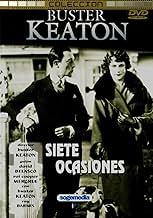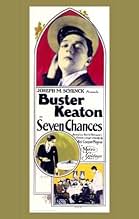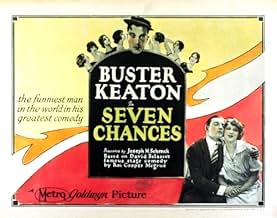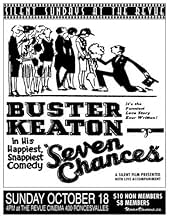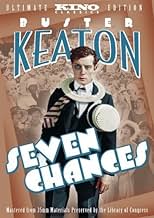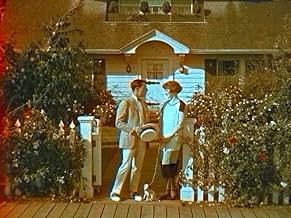IMDb रेटिंग
7.8/10
13 हज़ार
आपकी रेटिंग
अपनी भाषा में प्लॉट जोड़ेंA man learns that he will inherit a fortune if he marries by 7PM that evening.A man learns that he will inherit a fortune if he marries by 7PM that evening.A man learns that he will inherit a fortune if he marries by 7PM that evening.
- पुरस्कार
- 1 जीत और कुल 1 नामांकन
Frances Raymond
- Her Mother
- (as Frankie Raymond)
Jean Arthur
- Miss Smith - Office Receptionist
- (बिना क्रेडिट के)
Lori Bara
- Mother of Underage Girl
- (बिना क्रेडिट के)
Rosalind Byrne
- Hat Check Girl
- (बिना क्रेडिट के)
Louise Carver
- Prospective Bride Who Operates Crane
- (बिना क्रेडिट के)
फ़ीचर्ड समीक्षाएं
True love takes a lot of work - but this is ridiculous!
Jimmie Shannon (Buster Keaton) is a partner in a brokerage who can't quite bring himself to propose to Mary (Ruth Dwyer), the only woman he loves. Then, his business facing ruin, he discovers he stands to inherit a fortune if only he gets married that day. He proposes to Mary, but she's put off by his apparent insincerity. So Jimmie is left to find a woman, any woman, who will marry him. Will love prevail?
The film is an odd one for Keaton, starting off with a brief color sequence (in 1925) and moving quite slowly for Buster through the first third. The story was one Keaton had handed to him, rather than one he worked on himself, and feels at times like a "ladies' picture," focusing as it does on Jimmie's frustrated feelings and Mary's unhappiness.
For a while, Buster's not even the main laugh-getter in the film. For a while, he plays a kind of straight man to troll-visaged Snitz Edwards, playing the lawyer bringing the news of Jimmie's inheritance. Snitz chases after Jimmie and his partner, who think he's a process-server and dodge him, but Snitz prevails. Buster still pines for Mary, saying he can love no other woman (which she happens to hear over a telephone connection, changing her mind), but agrees to bring to bring a woman to church before the deadline out of loyalty to his partner.
"In case two show up, I'll marry the other," Snitz declares.
There are other oddities about "Seven Chances," like racial humor (Jimmie almost proposes to a black woman; a blackface actor plays a thick-headed hired hand) and the "Saphead"-style character Buster plays. It would seem like a lesser Keaton for that, but instead emerges as a masterwork of pacing and narrative. Just as you begin to settle in to "Seven Chances" tea-cozy aesthetic, it ramps things up for one of the great double-rally endings in movie history.
There's also a charming sequence where Jimmie tries to find a bride among a list of female members of his country club, the "seven chances" of the film's title. He burns through those chances in six minutes, and then gets rejected by a receptionist (Jean Arthur) and a hat-check girl (Rosalind Byrne) for good measure. The sequence plays with set design and framing to keep you always wondering as to what will happen next.
One amazing thing about the film you might not notice is the clever use of panning. Camera pans were still fairly new in cinema; framing was often stationary. But Buster is always in motion, and the camera moves with him. One clever shot, of Buster finding a turtle attached to his tie, apparently employs a treadmill in order to achieve an overhead camera angle.
The gags here keep coming, and give "Seven Chances" the feel of a classic Keaton short. Except there's a real story here to be told, and the humor always works to move the ideas forward. It's a classic demonstration of Keaton's ingenuity - even if he didn't have a hand in the film's conception or writing he directed it, and it shows - as well as his ability to find as many ways of making you laugh in as little time as possible.
Jimmie Shannon (Buster Keaton) is a partner in a brokerage who can't quite bring himself to propose to Mary (Ruth Dwyer), the only woman he loves. Then, his business facing ruin, he discovers he stands to inherit a fortune if only he gets married that day. He proposes to Mary, but she's put off by his apparent insincerity. So Jimmie is left to find a woman, any woman, who will marry him. Will love prevail?
The film is an odd one for Keaton, starting off with a brief color sequence (in 1925) and moving quite slowly for Buster through the first third. The story was one Keaton had handed to him, rather than one he worked on himself, and feels at times like a "ladies' picture," focusing as it does on Jimmie's frustrated feelings and Mary's unhappiness.
For a while, Buster's not even the main laugh-getter in the film. For a while, he plays a kind of straight man to troll-visaged Snitz Edwards, playing the lawyer bringing the news of Jimmie's inheritance. Snitz chases after Jimmie and his partner, who think he's a process-server and dodge him, but Snitz prevails. Buster still pines for Mary, saying he can love no other woman (which she happens to hear over a telephone connection, changing her mind), but agrees to bring to bring a woman to church before the deadline out of loyalty to his partner.
"In case two show up, I'll marry the other," Snitz declares.
There are other oddities about "Seven Chances," like racial humor (Jimmie almost proposes to a black woman; a blackface actor plays a thick-headed hired hand) and the "Saphead"-style character Buster plays. It would seem like a lesser Keaton for that, but instead emerges as a masterwork of pacing and narrative. Just as you begin to settle in to "Seven Chances" tea-cozy aesthetic, it ramps things up for one of the great double-rally endings in movie history.
There's also a charming sequence where Jimmie tries to find a bride among a list of female members of his country club, the "seven chances" of the film's title. He burns through those chances in six minutes, and then gets rejected by a receptionist (Jean Arthur) and a hat-check girl (Rosalind Byrne) for good measure. The sequence plays with set design and framing to keep you always wondering as to what will happen next.
One amazing thing about the film you might not notice is the clever use of panning. Camera pans were still fairly new in cinema; framing was often stationary. But Buster is always in motion, and the camera moves with him. One clever shot, of Buster finding a turtle attached to his tie, apparently employs a treadmill in order to achieve an overhead camera angle.
The gags here keep coming, and give "Seven Chances" the feel of a classic Keaton short. Except there's a real story here to be told, and the humor always works to move the ideas forward. It's a classic demonstration of Keaton's ingenuity - even if he didn't have a hand in the film's conception or writing he directed it, and it shows - as well as his ability to find as many ways of making you laugh in as little time as possible.
I'm sorry to hear that Keaton didn't care for this film, because it was a truncated version of this film that introduced me to Buster Keaton when I was about six.
When the film gets going, it really takes off and I mean off the ground. The big chase in this film is a joy to see.
This is a must see Keaton film.
When the film gets going, it really takes off and I mean off the ground. The big chase in this film is a joy to see.
This is a must see Keaton film.
Buster Keaton catapults himself down a steep hillside, an avalanche of pebbles, rocks and boulders tumbling in his wake. If any one of these objects were to strike him down, he would certainly be killed by the impact. He is almost escaping the rocks now; just a few more seconds of frantic sprinting is required. Suddenly, Keaton looks up, only to find a massive horde of woman striding purposefully towards him. He is stuck between a rock and a hard place: an avalanche behind him, and a flock of would-be brides ahead. Quickly and delicately weighing his chances of survival either way, Keaton turns determinedly towards the barrage of boulders. It is hilarious little moments like this that make Buster Keaton's silent comedies such a joy to watch, and 'Seven Chances' is certainly one of the funniest I've seen, brimming with the talented actor's trademark deadpan humour.
The premise on which the story is based is singularly ridiculous, and so this allows Keaton to have a great deal of fun, placing his character in appropriately bizarre situations. Young Jimmy Shannon (Keaton) loves his sweetheart Mary Jones (Ruth Dwyer), but can never quite muster up the courage to tell her, and most certainly could never take that plunge into marriage. However, one day he discovers that his grandfather has left him the princely sum of $7 million, but only if he gets married by 7 PM that day! After he is rejected by Mary (due to an unfortunate misunderstanding), Jimmy seeks out another would-be bride, ultimately realising that finding a wife isn't as easy as he had hoped. The first half of the film is admittedly light on Keaton's patented stunt-work, but it remains a clever and witty situation comedy, with poor Jimmy suffering the laughter of onlookers as he moves from one girl to the next, tentatively asking for their hands in marriage.
When all this fails, an advertisement in the afternoon-edition newspaper brings hundreds of women to Jimmy's side, but by now he's realised that Mary is the only girl he could ever marry. As he struggles desperately to get to her home by 7:00, he is pursued by a horde of money-crazy ladies: big and small, young and old, beautiful and ugly. This is truly where Keaton comes into his element, and a hectic scramble down a hillside pursued by an avalanche of rocks is the film's most memorable moment {the idea for this scene came by accident, when Keaton inadvertently dislodged some rocks while he was running. The preview audience responded so favourably that he decided to re-shoot an extended sequence}. The paper-mâché rocks look quite convincing, and I was pretty much fooled into thinking that Keaten was really dodging the real thing (until I noticed him get bowled over by one of the boulders, without any apparent ill-effects!) 'Seven Chances' moves by at such a frenetic pace that there isn't a moment that could be trimmed. Though it runs for just 56 minutes, I had a huge smile on my face for every single one of them.
The premise on which the story is based is singularly ridiculous, and so this allows Keaton to have a great deal of fun, placing his character in appropriately bizarre situations. Young Jimmy Shannon (Keaton) loves his sweetheart Mary Jones (Ruth Dwyer), but can never quite muster up the courage to tell her, and most certainly could never take that plunge into marriage. However, one day he discovers that his grandfather has left him the princely sum of $7 million, but only if he gets married by 7 PM that day! After he is rejected by Mary (due to an unfortunate misunderstanding), Jimmy seeks out another would-be bride, ultimately realising that finding a wife isn't as easy as he had hoped. The first half of the film is admittedly light on Keaton's patented stunt-work, but it remains a clever and witty situation comedy, with poor Jimmy suffering the laughter of onlookers as he moves from one girl to the next, tentatively asking for their hands in marriage.
When all this fails, an advertisement in the afternoon-edition newspaper brings hundreds of women to Jimmy's side, but by now he's realised that Mary is the only girl he could ever marry. As he struggles desperately to get to her home by 7:00, he is pursued by a horde of money-crazy ladies: big and small, young and old, beautiful and ugly. This is truly where Keaton comes into his element, and a hectic scramble down a hillside pursued by an avalanche of rocks is the film's most memorable moment {the idea for this scene came by accident, when Keaton inadvertently dislodged some rocks while he was running. The preview audience responded so favourably that he decided to re-shoot an extended sequence}. The paper-mâché rocks look quite convincing, and I was pretty much fooled into thinking that Keaten was really dodging the real thing (until I noticed him get bowled over by one of the boulders, without any apparent ill-effects!) 'Seven Chances' moves by at such a frenetic pace that there isn't a moment that could be trimmed. Though it runs for just 56 minutes, I had a huge smile on my face for every single one of them.
Jimmie Shannon (Buster Keaton) is a broker in need of money. When a lawyer comes to tell him he has inherited a certain sum, Jimmie avoids him thinking he may be bringing a summons. And then when he does hear the good news, there's a catch...
Directed by and starring Buster Keaton, this film portrays his particular brand of physical comedy, though perhaps not with as much danger as "The General" or as many tricks as "Sherlock Jr." The music of Robert Israel really carries this film. Not just because it's a silent film, but because it's great music -- moving, light and comedic. And there is an implied racial tone... Jimmie passes on proposing to both a Jew and a black woman.
I literally "laughed out loud" at this film! It is a shame Keaton considered it his worst film. Who knew it was so hard to get someone to marry you for $7,000,000 (in 1925 money, no less)?
Directed by and starring Buster Keaton, this film portrays his particular brand of physical comedy, though perhaps not with as much danger as "The General" or as many tricks as "Sherlock Jr." The music of Robert Israel really carries this film. Not just because it's a silent film, but because it's great music -- moving, light and comedic. And there is an implied racial tone... Jimmie passes on proposing to both a Jew and a black woman.
I literally "laughed out loud" at this film! It is a shame Keaton considered it his worst film. Who knew it was so hard to get someone to marry you for $7,000,000 (in 1925 money, no less)?
Desperate for money to save his failing business, junior stockbroker Buster Keaton (as James "Jimmie" Shannon) is understandably pleased to learn his recently deceased grandfather has tentatively left him $7 million. In order to inherit the money, Mr. Keaton must get married by 7 pm. After a misunderstanding with girlfriend Ruth Dwyer (as Mary Jones), Keaton gets "Seven Chances" to propose, but each woman turns him down. When a newspaper article reveals Keaton's potential, every woman in the vicinity decides to pursue him. Keaton decides marrying Ms. Dwyer is the correct way to go, if he can get away from a landslide of eager women...
Lost on modern audiences is a moment when Keaton visits a theater to propose marriage to a showgirl, who we're told is Julian Eltinge; filmgoers in 1925 would have known this was a female impersonator. Another of Keaton's prospects in young Jean Arthur (as "Miss Smith"). The colorful opening gives "Seven Chances" a great start, but frequent "ethnic" humor is not funny. It's hard to believe Keaton considered this film substandard. Even before it gets going, it's a top quality production. There are enough chuckles before the famous chase scene, which really begins when Keaton falls asleep in church and the women start rushing to meet him.
******** Seven Chances (3/11/25) Buster Keaton ~ Buster Keaton, Ruth Dwyer, Snitz Edwards, T. Roy Barnes
Lost on modern audiences is a moment when Keaton visits a theater to propose marriage to a showgirl, who we're told is Julian Eltinge; filmgoers in 1925 would have known this was a female impersonator. Another of Keaton's prospects in young Jean Arthur (as "Miss Smith"). The colorful opening gives "Seven Chances" a great start, but frequent "ethnic" humor is not funny. It's hard to believe Keaton considered this film substandard. Even before it gets going, it's a top quality production. There are enough chuckles before the famous chase scene, which really begins when Keaton falls asleep in church and the women start rushing to meet him.
******** Seven Chances (3/11/25) Buster Keaton ~ Buster Keaton, Ruth Dwyer, Snitz Edwards, T. Roy Barnes
क्या आपको पता है
- ट्रिवियाBuster Keaton had this project foisted upon him by producer Joseph M. Schenck, who had bought the rights to the hit Broadway show. Keaton later called it his least favorite feature and tried to keep film historian Raymond Rohauer from restoring the only known copy of the movie.
- गूफ़Just as the horde of would-be brides overruns the college football game, one of the players can be seen throwing himself to the ground, already pretending to be trampled.
- भाव
Title Card: By the time Jimmie had reached the church, he had proposed to everything in skirts, including a Scotchman.
टॉप पसंद
रेटिंग देने के लिए साइन-इन करें और वैयक्तिकृत सुझावों के लिए वॉचलिस्ट करें
- How long is Seven Chances?Alexa द्वारा संचालित
विवरण
बॉक्स ऑफ़िस
- दुनिया भर में सकल
- $268
- चलने की अवधि56 मिनट
- रंग
- ध्वनि मिश्रण
- पक्ष अनुपात
- 1.33 : 1
इस पेज में योगदान दें
किसी बदलाव का सुझाव दें या अनुपलब्ध कॉन्टेंट जोड़ें

![Trailer [OV] देखें](https://m.media-amazon.com/images/M/MV5BNTUxNzY1MzYtN2MzMS00Yzc0LWIyNmMtYTE1ZmJhYTlkMDI4XkEyXkFqcGdeQXRyYW5zY29kZS13b3JrZmxvdw@@._V1_QL75_UX500_CR0)

